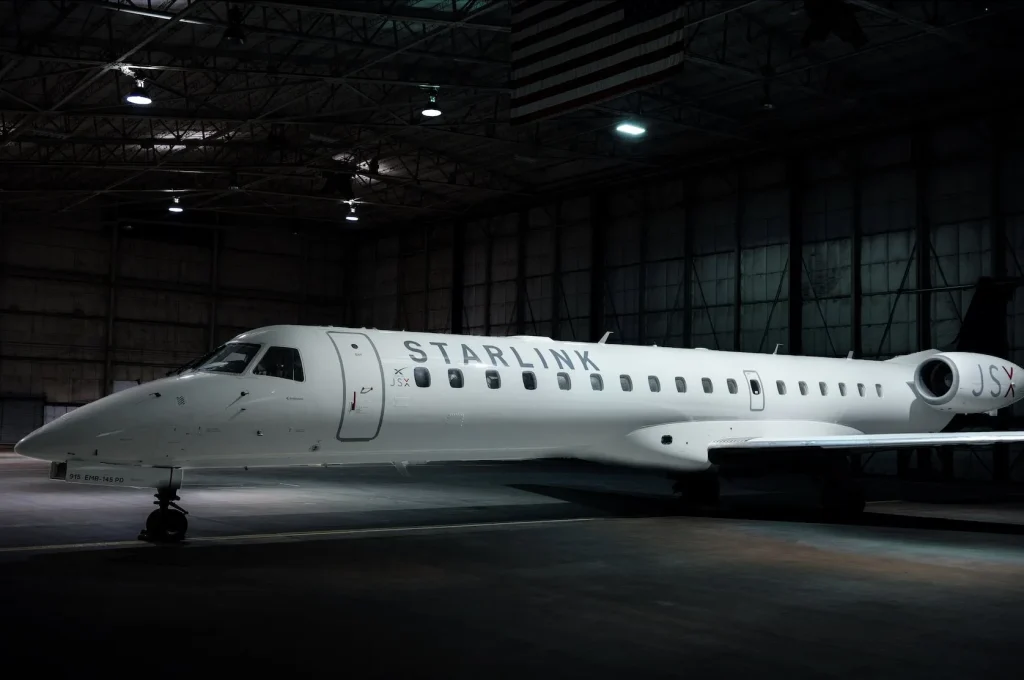
Starlink Aviation, an extension of SpaceX’s ambitious Starlink project, marks a revolutionary step in enhancing in-flight internet connectivity. Launched by Elon Musk’s SpaceX, Starlink’s primary mission has been to provide high-speed, low-latency internet service globally through a constellation of low Earth orbit (LEO) satellites. Starlink Aviation aims to bring these benefits to the skies, offering unparalleled connectivity to commercial airlines, private jets, and even military aviation sectors.
The inception of Starlink Aviation stems from the growing demand for consistent and fast internet access during flights, a need that traditional geostationary satellite systems have struggled to fulfill adequately due to their high latency and lower speeds. By leveraging Starlink’s LEO satellites, Starlink Aviation promises to transform the in-flight experience, enabling passengers to enjoy high-speed internet comparable to what they experience on the ground.
This initiative not only underscores SpaceX’s commitment to expanding internet accessibility but also highlights the potential for significant advancements in the aviation industry’s approach to in-flight services and operations. As we delve deeper into the technological innovations and benefits Starlink Aviation brings to the table, it becomes evident how it could redefine airborne connectivity standards.
Technological Innovation and Features
At the core of Starlink Aviation’s breakthrough service is a constellation of over a thousand low Earth orbit (LEO) satellites, a number that SpaceX plans to significantly increase. These satellites operate much closer to the Earth compared to traditional geostationary satellites, at altitudes ranging from 550 to 1,200 kilometers. This proximity reduces the time it takes for signals to travel between the Earth and the satellites, resulting in lower latency and higher speeds for end-users. For the aviation industry, this technological innovation means that aircraft can now access internet speeds of up to 350 Mbps, transforming the in-flight experience for passengers and crews alike.
The onboard equipment for Starlink Aviation is designed to be aerodynamically efficient and includes a phased-array antenna that enables the aircraft to maintain a continuous, high-speed connection to the satellites as it moves. This is a significant advancement over older systems, which often lose signal strength or experience delays when switching between satellites. The Starlink system dynamically adjusts the beam direction of the antenna, ensuring an uninterrupted connection even at high speeds and over remote areas where traditional satellite coverage is poor or nonexistent.
Furthermore, Starlink Aviation’s infrastructure is bolstered by a network of ground stations spread across the globe. These ground stations serve as the link between the satellite constellation and the internet backbone on the ground, facilitating a seamless flow of data to and from the aircraft. This comprehensive approach not only enhances connectivity but also ensures a consistent service quality irrespective of the aircraft’s location.
The introduction of such advanced technology into aviation has set Starlink Aviation apart from existing in-flight internet services. With its capability to provide high-speed, low-latency connectivity, Starlink Aviation offers a range of features that significantly improve both operational efficiencies for airlines and the overall flight experience for passengers. These include faster browsing speeds, high-definition video streaming, reliable and secure communications for cockpit operations, and real-time data exchange for improved flight management and safety.
Benefits for the Aviation Industry
The advent of Starlink Aviation introduces a myriad of benefits for the aviation industry, fundamentally altering how airlines, private jet operators, and military aviation approach in-flight connectivity. The implications of this high-speed, low-latency internet service are profound, ranging from enhanced passenger experience to improved operational efficiencies and safety.
Suitable Aircraft for Starlink Aviation
Starlink Aviation is compatible with a wide range of aircraft, making it a versatile option for different segments of the aviation industry. The technology is not only designed for large commercial airliners but also fits perfectly with business jets and regional aircraft, ensuring that a broad spectrum of aviation operations can benefit from enhanced connectivity. Notable aircraft models that are particularly well-suited for Starlink Aviation installations include:
- Commercial Jets:
- Airbus A321Neo: A highly efficient and popular narrow-body airliner perfect for short to medium-haul routes.
- Business Jets:
- Bombardier Global 6000, Global Express, and Global Express XRS: These long-range business jets offer spacious cabins and are ideal for installing Starlink’s equipment, providing global connectivity to business travelers.
- Gulfstream G450, G550, G650, G650ER, and GV: Known for their performance, range, and luxury, Gulfstream models stand to benefit significantly from the seamless internet connectivity Starlink Aviation provides.
- Regional and Utility Aircraft:
- Beechcraft Super King Air 200/300: A versatile twin-turboprop aircraft often used for business, medical evacuations, and utility purposes.
- Embraer ERJ-135 and ERJ-145: Regional jets that serve short to medium-haul routes can offer passengers enhanced in-flight connectivity with Starlink Aviation, improving the travel experience on shorter journeys.
The inclusion of Starlink Aviation across these diverse types of aircraft can significantly enhance the value proposition for airlines and private operators. By offering high-speed, reliable internet access, these aircraft can deliver an unmatched in-flight experience, making air travel more productive and enjoyable for passengers while improving operational capabilities for the crew.
1. Enhanced Passenger Experience: Passengers aboard aircraft like the Airbus A321Neo or the luxurious Gulfstream G650ER can enjoy uninterrupted high-speed internet, making flights more enjoyable and productive. This connectivity is a game-changer for passenger satisfaction and loyalty.
2. Operational Efficiencies: Aircraft equipped with Starlink Aviation, such as the Bombardier Global Express or the Embraer ERJ-145, benefit from real-time data for optimized route planning, improved safety, and predictive maintenance, leading to significant cost savings and enhanced service reliability.
3. Improved Safety and Market Differentiation: The broad range of compatible aircraft also means that Starlink Aviation can help operators distinguish themselves in a competitive market. Offering superior in-flight connectivity can be a deciding factor for passengers when choosing airlines or charter services, especially for those flying on business jets like the Gulfstream series or utilizing the practicality of the Beechcraft Super King Air for shorter trips.
1. Enhanced Passenger Experience: In today’s digital age, passengers expect constant connectivity, and Starlink Aviation meets this demand head-on. With speeds capable of supporting high-definition video streaming, video calls, and large file downloads, passengers can stay connected for work or leisure as if they were on the ground. This level of service not only boosts passenger satisfaction but also gives airlines a competitive edge, potentially increasing loyalty and revenue through added value services.
2. Operational Efficiencies: For airlines and private jet operators, the operational benefits of Starlink Aviation are significant. High-speed, reliable internet enables better communication between the cockpit and ground control, facilitating real-time weather updates, route optimizations, and critical flight information exchange. This can lead to more efficient flight paths, reduced fuel consumption, and enhanced safety. Moreover, maintenance teams can access real-time data about the aircraft’s performance, allowing for predictive maintenance and minimizing downtime.
3. Improved Safety: Enhanced connectivity improves safety by ensuring that pilots have access to the latest weather information and can maintain constant communication with air traffic control. In emergency situations, the ability to swiftly transmit and receive information can be life-saving.
4. Market Differentiation: Airlines offering Starlink’s high-speed internet can differentiate themselves in a competitive market. By providing an unparalleled in-flight connectivity experience, carriers can attract business travelers and tech-savvy passengers who value productivity and entertainment during their flights.
5. Military Applications: Beyond commercial aviation, Starlink Aviation holds promise for military applications. Reliable, secure communication is critical for military operations, and Starlink’s global coverage can significantly enhance the capabilities of military aircraft, improving situational awareness, command and control communications, and logistical support.
The introduction of Starlink Aviation into the market addresses long-standing connectivity issues in the aviation industry, setting new standards for what passengers and operators can expect from in-flight internet service. As airlines and private jet operators begin to adopt this technology, the ripple effects will likely influence future developments in aviation technology, passenger services, and operational strategies.
Challenges and Limitations
Despite the groundbreaking potential of Starlink Aviation, several challenges and limitations could temper its rapid adoption and impact within the aviation industry. These hurdles span regulatory, technical, and competitive realms, each presenting distinct obstacles to widespread implementation.
1. Regulatory Hurdles: One of the most significant challenges for Starlink Aviation is navigating the complex web of global and regional aviation regulations. Obtaining the necessary certifications for onboard equipment and ensuring compliance with various jurisdictions’ air safety standards is a time-consuming and potentially costly endeavor. Additionally, the use of satellite frequencies for aviation requires approval from telecommunications authorities, which can vary significantly by country.
2. Infrastructure Costs: For airlines, the upfront investment in retrofitting aircraft with Starlink’s phased-array antennas and onboard equipment may be substantial. While the promise of enhanced passenger satisfaction and operational efficiencies is appealing, the initial costs could deter smaller operators or those with tight budget constraints from early adoption.
3. Technical Limitations: Although Starlink’s LEO satellites offer lower latency and higher speeds than traditional satellite services, the system’s performance in adverse weather conditions or in extremely remote regions remains to be thoroughly tested in aviation contexts. Moreover, as the number of aircraft equipped with Starlink increases, managing bandwidth to ensure consistent service quality across densely populated flight paths will be critical.
4. Competition: Starlink Aviation enters a market with established satellite internet providers who are also investing in technology upgrades and expanding their services. Competitors may leverage their existing relationships with airlines and regulatory bodies to challenge Starlink’s entry or undercut its market potential through competitive pricing or bundled services.
5. Security Concerns: The reliance on satellite internet for critical flight communications and operations introduces cybersecurity risks. Ensuring the security of data transmission against potential threats will be paramount for Starlink Aviation to gain the trust of the aviation industry and regulatory bodies.
Despite these challenges, the innovative approach and technological superiority of Starlink Aviation offer compelling reasons for its potential success. Overcoming these obstacles will require strategic planning, significant investment, and ongoing adaptation to the evolving needs of the aviation industry and regulatory environments.
Future Prospects and Industry Impact
Looking ahead, the future of Starlink Aviation appears promising, with the potential to significantly impact the aviation industry and global connectivity. As SpaceX continues to expand its satellite constellation and refine its technology, the possibilities for enhancing in-flight internet service and beyond are vast.
1. Expansion and Technological Advancements: Continued advancements in satellite technology and the expansion of the Starlink constellation will further improve service quality and reliability. SpaceX’s ongoing innovation may also reduce the cost and size of onboard equipment, making it more accessible to a wider range of aircraft.
2. Broader Industry Impact: The widespread adoption of Starlink Aviation could set new standards for in-flight connectivity, pushing competitors to innovate and improve their services. This could lead to a more connected, efficient, and enjoyable flying experience across the industry.
3. Global Connectivity: Beyond its implications for the aviation industry, Starlink Aviation contributes to SpaceX’s broader mission of global internet coverage. Enhanced connectivity in remote or underserved regions could have far-reaching effects on global communication, economic development, and access to information.
4. Potential Market Shifts: As airlines and private jet operators begin to offer unparalleled in-flight connectivity, passenger expectations will evolve, potentially influencing flight choices based on available internet services. This shift could impact airline competitiveness and market dynamics.
5. Environmental Considerations: Improved operational efficiencies facilitated by Starlink’s connectivity could contribute to more fuel-efficient flight paths and reduced carbon emissions, aligning with the aviation industry’s sustainability goals.
In conclusion, while Starlink Aviation faces challenges and limitations, its potential benefits for the aviation industry and global connectivity are undeniable. As it navigates regulatory landscapes and technological hurdles, its success will likely influence future innovations in aviation technology and services, marking a significant step forward in the quest for universal high-speed internet access.
Ready to bring the future of high-speed internet to your aircraft? Contact Starlink Installation Pros, your expert partner in seamless Starlink Aviation installations. Whether you’re looking to enhance passenger experience, improve operational efficiencies, or stay ahead in the competitive aviation market, our team is equipped to deliver top-tier installation services. Visit our website or call us today to learn more about how we can transform your in-flight connectivity with Starlink Aviation.


